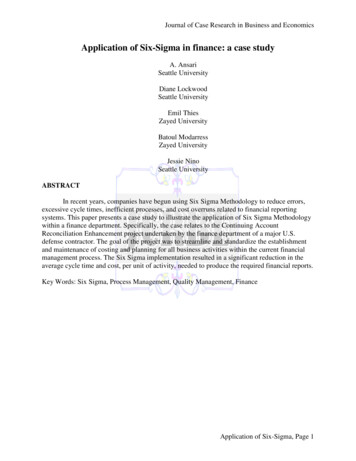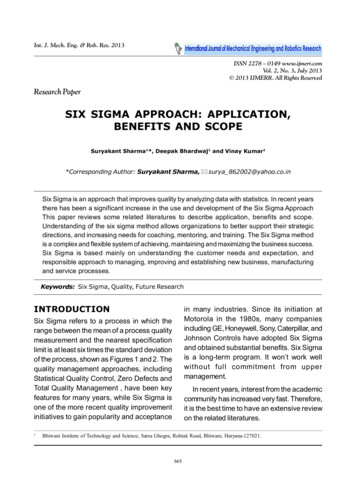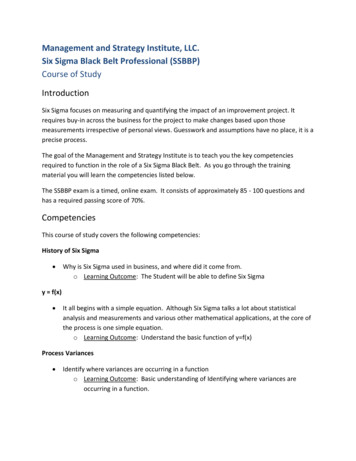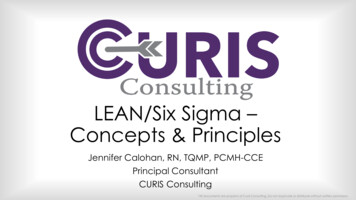
Transcription
Journal of Case Research in Business and EconomicsApplication of Six-Sigma in finance: a case studyA. AnsariSeattle UniversityDiane LockwoodSeattle UniversityEmil ThiesZayed UniversityBatoul ModarressZayed UniversityJessie NinoSeattle UniversityABSTRACTIn recent years, companies have begun using Six Sigma Methodology to reduce errors,excessive cycle times, inefficient processes, and cost overruns related to financial reportingsystems. This paper presents a case study to illustrate the application of Six Sigma Methodologywithin a finance department. Specifically, the case relates to the Continuing AccountReconciliation Enhancement project undertaken by the finance department of a major U.S.defense contractor. The goal of the project was to streamline and standardize the establishmentand maintenance of costing and planning for all business activities within the current financialmanagement process. The Six Sigma implementation resulted in a significant reduction in theaverage cycle time and cost, per unit of activity, needed to produce the required financial reports.Key Words: Six Sigma, Process Management, Quality Management, FinanceApplication of Six-Sigma, Page 1
Journal of Case Research in Business and EconomicsINTRODUCTIONIn 1987, Motorola developed and organized the Six Sigma process improvementMethodology to achieve “world-class” performance, quality, and total customer satisfaction.Since that time, at least 25% of the Fortune 200, including Motorola, General Electric, Ford,Boeing, Allied Signal, Toyota, Honeywell, Kodak, Raytheon, and Bank of America, to name afew, have implemented a Six Sigma program (Antony et al. 2008, Hammer, 2002). Thesecompanies claim that Six Sigma has significantly improved their profitability (Hammer, 2002).For example, in 1998 GE claimed benefits of 1.2 billion and costs of 450 million, for a netbenefit of 750 million. The company’s 1999 annual report further claimed a net benefit of morethan 2 billion through the elimination of all non–value added activities in all business processeswithin the company (Lucas, 2002). Similarly, Allied Signal reported that Six Sigma was a majorfactor in the company’s 1.5 billion in estimated savings (Lucas, 2002). Six Sigma has alsoenabled Honeywell to reduce the development time required to redesign Web sites by 84% forits specialty materials (Maddox, 2004b).Six Sigma has been defined as a management strategy for improving product and processquality (Hahn et al. 2000, Harry and Schroeder, 2000, Sanders and Hild, 2000). It is also astatistical term used to measure process variations, i.e., how far a given process deviates fromperfection, which causes defects. Six Sigma works to systematically manage variation andeliminate defects--or to get them as close to zero as possible (Harrison, 2006). Six Sigmainitiatives have typically been implemented on shop floors of manufacturing firms to manage“process variations” (defects or errors), to improve quality and productivity (Revere and Black,2003), and as a result, to increase the profitability of a company (Aggogeri and Gentili, 2008,Anand et al., 2007, Lucas, 2002).Functional support areas such as finance, accounting, marketing, human resources,procurement, and retail, however, have generally not kept pace with manufacturing inimplementing Six Sigma programs. In part, this is due to the rigorous statistical requirements ofapplications that were considered too difficult to be applied within other functional areas or topredominantly service organizations (Harrison, 2006, Pyzdek, 2003, Watson, 2004). Forexample, in the areas of finance and accounting, Six Sigma has been used only to monitor andmeasure the financial impact of a program on the shop floor, in spite of the fact that, according toa 2005 Ernst & Young study (cited in Juras et al., 2007), 14% of public companies haveineffective internal controls, which results in output errors, excessive cycle times, inefficientprocesses, and cost overruns.This paper presents a case study of Six Sigma as practiced in the finance departmentwithin a major division (hereafter referred as IDS) of a leading defense contract manufacturer.Purposes of this paper were to describe the application of the Six Sigma Methodology instreamlining the financial reporting process within the finance division of IDS, to reportpreliminary findings, and to examine conditions which contributed to the successfulimplementation. The company’s name and other attributes have been altered for reasons ofconfidentiality.A detailed review of Six Sigma literature was not deemed necessary for the purpose ofthis case study since the literature is well known and pervasive, at least within manufacturingoperations. First, this study will briefly summarize the five phases of the Six SigmaMethodology. Next, it will briefly describes the application of Six Sigma in various functionalareas other than manufacturing operations. Third, the paper presents an overview of the SixApplication of Six-Sigma, Page 2
Journal of Case Research in Business and EconomicsSigma initiative at IDS, to provide a context for the case study. Finally, the actualimplementation of Six Sigma Methodology in the Account Reconciliation process is discussedalong with preliminary performance results.WHAT IS SIX SIGMA?Over the past two decades Six Sigma has evolved from a focus on metric to theMethodology level and finally to the design and development of entire Management Systems. Asa Metric, when a process is operating at Six Sigma level, it will produce nonconformance (i.e.,defects or errors) at a rate of not more than 3.4 defects per one million opportunities. As aMethodology, Six Sigma leads to business process improvement by focusing on understandingand managing customer expectations and requirements (Brewer and Eighme, 2005; Rudisill andClary, 2004). As a Management System, Six Sigma is used to ensure that critical improvementopportunity efforts developed through the Metrics and Methodology levels are aligned with thefirm’s business strategy. The focus of this paper, however, is on the application of Methodologyfor business process improvement within the financial reporting process.The core of the Six Sigma Methodology level is DMAIC which stands for define, measure,analyze, improve, and control. These are explained in detail in the following sections. In theDefine phase, the project team must work closely with stakeholders to clearly define the problemstatement, project scope, budget, schedule, and constraints. Understanding customer (internaland external) requirements is the key to achieving the project’s goal. The team has to defineproblems and goals of the project that are consistent with customer demands and with the firm’sbusiness strategy. Process mapping and “voice of the customer” (VOC) tools are iterativetechniques recommended as a means of incorporating customer requirements.During the Measure phase, the team creates a value stream mapping (VSM) of theprocess, capturing the flow of information—where and what information is needed. Then, basedon the VSM, the team starts collecting data relevant to measuring the current processperformance relative to the project’s goals. The most important activities in this phase are theidentification and validation of data accuracy. The most widely used tools are VSM, run charts,brainstorming, balanced scorecards, documentation tagging, data collection check sheets, anddecision metrics.During the Analyze phase, the team needs to collect and analyze the data to understandthe key process input variables that affect the project’s goal, such as whether time spent oncurrent activities is value added or non–value added. A VMS may be used as part of the overallanalysis to generate a list of potential root causes for why the process is not performing asdesired. The tools that can be used are process flow chart, value stream mapping, cause-andeffect diagram, Pareto analysis, histograms, control charts, and root cause analysis.During the Improve phase, the team needs to design and conduct experiments (DOE) on asmall scale using a formal evaluation process to identify and evaluate optimal or desiredalternatives against the established criteria. A list of all possible solutions should be developed,enabling the team to eliminate the root causes of problems. The recommended tools includebrainstorming, cost-benefit analysis, priority metrics, failure mode and effect analysis, andprocess flow diagrams.Finally, during the Control phase, the team should standardize and document the newprocess to support and sustain desired improvements. To sustain long-term improvements, howthe improved process is expected to result in operational and financial improvements (Foster,Application of Six-Sigma, Page 3
Journal of Case Research in Business and Economics2007) should be transparent to all employees. Tools used include statistical process controlcharts, flow diagrams, and pareto charts.APPLICATIONS OF SIX SIGMAIn recent years, a number of manufacturing and service companies have realized that SixSigma Methodology is flexible enough to be applied throughout all business functions. Examplesof Six Sigma applications in different functional areas other than manufacturing operations arediscussed next.Sales and MarketingIn recent years, several companies have considered using Six Sigma to improvemarketing processes. For example, the marketing and sales organizations at GE and Dow havebeen using Six Sigma for new product development and customer support to reduce costs,improve performance, and increase profitability (Maddox, 2004a). Other companies use SixSigma in marketing and sales as a road map to capture market data and competitive intelligencethat will enable them to create products and services that meet customers’ needs (Pestorius,2007; Rylander and Provost, 2006). Rylander and Provost (2006) suggest that companies shouldcombine Six Sigma Methodology and online market research for better customer service, andPestorius (2007) noted that Six Sigma could improve sales and marketing processes.Accounting and FinanceThe Six Sigma Methodology has made its way into the accounting function and hascontributed to reduced errors in invoice processing, reduction in cycle time, and optimized cashflow (Brewer and Bagranoff, 2004). The accounting department at a healthcare insuranceprovider, for instance, developed an applied Six Sigma Methodology to improve accountwithdrawal accuracy. Prior to Six Sigma implementation, rectifying an error in the billingprocess involved a number of reconciliation checkpoints and manual workflow, which resultedin 60% of customer accounts being charged less than the amount due and about 40% beingovercharged. After Six Sigma implementation, the defect rate reached near zero and cycle timeswere reduced from two weeks to three days (Stober, 2006). The U.S. Coast Guard FinanceCenter used Six Sigma to create a new standardized process for accounts payable services, whichimproved customer satisfaction levels (Donnelly, 2007).A number of companies have applied Six Sigma to the finance process to reducevariability in cycle times, error rates, costs, “days to pay” of accounts payable, and improveemployees’ productivity ratios (Brewer and Bagranoff, 2004; McInerney, 2006). Othercompanies have used Six Sigma to reduce the cycle time of the quarterly financial reportingprocess (Brewer and Eighme, 2005) and to reduce the time needed to close books, reducevariability in financial reporting, improve shareholder value, and increase the accuracy of thefinance process (Gupta, 2004). Foster (2007) conducted a longitudinal study comparing thefinancial performance of companies who had implemented Six Sigma programs with those whodid not have such a programs. He found significant effects for those firms using Six Sigma onfree cash flow, earnings, and asset turnover. Six Sigma, however, did not appear to affect salesreturn on assets, return on investment, or firm growth. As a result, Foster (2007) suggested ifApplication of Six-Sigma, Page 4
Journal of Case Research in Business and Economicsfirms want to improve cash flow, earnings, or productivity in using assets, Six Sigma may of use.He also found that the companies with low cash flow and no Six Sigma programs did better thancompanies using Six Sigma. He suggested that for cash poor firms, Six Sigma may be a drain onresources in that these companies may not have the cash and time necessary to sustain effectiveSix Sigma results over time.In another industry level analysis, York and Miree (2004) studied the link betweenquality improvement programs and financial performance. They studied the financialperformance of “quality award winning” companies against SIC control groups both before andafter winning the award. They found that quality award winning firms had better financialperformance both before and after winning quality awards, suggesting that winning the awardwas a covariate for financial success.Most studies have attempted to assess the impact of Six Sigma on financial performancehave occurred at the aggregate industry level of analyses. Very few actual case studies have beenreported of the impact of Six Sigma on the finance process itself. That is, how Six Sigma canchange the way in which finance conducts its various work activities and the resulting impact hasseldom been documented in the literature. This case study attempts to address this gap at themore micro level of within firm process analysis.SIX SIGMA AT IDSThis case study is based on the information gathered from IDS’s implementation of acompanywide Six Sigma initiative. The Six Sigma initiative at IDS was developed bybenchmarking the best practices of two other defense contractors, as well as Toyota’s LeanThinking model, to meet the stringent standard requirements of the Department of Defense. Theinitiative at IDS received the total commitment of senior executives, a consortium of external SixSigma experts, and a group of highly trained individuals throughout the company’s businessdivisions.The Six Sigma team was comprised of a full-time master expert (Master Black Belt -- acommon Six Sigma designation for the project leader) and a network of internal experts (BlackBelts) working very closely with project managers. The primary goal of the team was to developan overall Six Sigma strategy consistent with customers’ requirements and the company’smission statement. The long-term goal of the team was to create special-level projectopportunities for the division that could eventually lead to cultural change in the workplace.Forty projects were identified that encompassed the division’s business profile. Using a formalstandardized metric, the team prioritized a list of project opportunities in order of theiranticipated contribution to the goals of the company.In the next section, the implementation of DMAIC Methodology in one of these 40projects i.e., the Continuing Account Reconciliation Enhancement (CARE) project is discussedin detail.DefineThrough collaborative efforts with other stakeholders in the project, the team visualizedan opportunity to develop and document a standardized process for establishing and maintainingcost and financial planning for all business divisions within its current financial system. Theprimary stakeholders in this project were from the finance organization, which is responsible forApplication of Six-Sigma, Page 5
Journal of Case Research in Business and Economicsgenerating cost analyses and other financial reports for managements’ consideration. The teamhad the commitment of the vice president of the division, who sponsored the CARE project. Theprocess entailed identifying undesirable or non–value added activities within the current process,implementing improvements in control systems for achieving sustainability, and deliveringmeasurable results that change the way people think and act.The Six Sigma team began by working with internal customers to define the objectives ofthe project, including the deliverable, opportunity statement, scope, schedule, budget, andconstraints. The team defined the current problem as “the process cannot produce all FinancialPlanning and Analysis (FP&A) requirements in the most efficient and effective manner.” Theprimary objective of the project, therefore, was to streamline and document all cost elements inthe planning process for the current financial system.To achieve the objective, the Six Sigma team recognized two primary issues. First, therewas a need to clarify and simplify the current financial reporting process for internal customersby identifying all non–value added and confusing steps to reduce reporting cycle time and cost.Second, the team envisioned an improved process for both internal (called Firm contracts) andexternal customers (called Non-Firm) companies who outsourced their financial reporting toIDS. The improved processes were expected to result in more timely, complete, and accuratedata for planning.MeasureAt this stage, the team conducted value stream mapping analysis to measure theperformance of the current reporting process in terms of average hours required to complete theFP&A reports and the subsequent cost of preparing all the reports using activity based costing(ABC) methods. The existing cost and financial planning process was not clearly documented orconsistently followed, which often resulted in rework and dual update loops, as shown in Figure1 (Appendix).These loops inevitably create opportunities for non–value added activities such as errors,excess movement, additional IT training and maintenance costs, inconsistent data, and waitingtime to creep into the process. For example, in step 1 on Figure 1, when an internal (Firm)contract was received it was entered into SAP; whereas Non-Firm business was not entered intobusiness planning and simulation (BPS) software until it was required by the five-year plan,resulting in delays and substantial variations in the process. In step 2, when a project is notdefined, it costs more and delays the process because the finance department has to request moreinformation (step 3). Only when a project definition was sufficiently established for a Firm for acontract, will a transaction be opened in SAP in step 4.Another problem with the existing process, step 5, was that the financial reporting forproject definition was produced with data from the Business Information Warehouse (BIW),which is a combination of databases, and database management tools that are used to supportmanagement decision making. The BIW is used in SAP and as well as other applications tosupport management decision making. In step 6, the project cost plans were not necessarilydeveloped by the finance team for the program (i.e., the Cost Experts), and preparersconsequently used a myriad of different financial tools (e.g., Microsoft Excel, BPS, etc.). Next,in step 7, cost element breakouts were defined using input from the various reporting tools. TheNon-Firm data was added in BPS as requested by external clients, and Firm data was enteredinto SAP for the five-year plan FP&A requirements. In step 8, the analysis was prepared alongApplication of Six-Sigma, Page 6
Journal of Case Research in Business and Economicswith reports and presentations. Finally, in step 9 the FP&A’s were revised to incorporatemanagement change requests and both SAP and BPS data bases were updated as needed.The team found that they were spending, on average 150 hours to produce 10 internalFirm financial statements and 50 hours on 10 outside Non-Firm reports. In summary, the financedepartment spent a total of 200 hours to generate 20 reports (including the ongoing costs ofpreparing 12 monthly reports) for an overall cost of 360,000. Using activity based-costingprinciples the cost of an activity is equal to: Volume x Time x Labor Cost. In this case, thiswould be equal to 32 reports times 200 hours times a fully burden labor costs for a total of 360,000.AnalysisThe team began this stage by creating a cause-and-effect diagram, as shown in Figure 2(Appendix). This tool is used to identify possible root causes of why “the process cannotproduce all cost and FP&A requirements in the most efficient and effective manner.” The teamidentified three major causes and grouped them into the following categories:1. Lack of complete Firm cost and financial plans2. Multiple sources of data and databases3. Lack of complete Non-Firm cost and financial plansNext, the team used these categories as the basis for further detailed analysis to identifythe contributing factors for each major cause, as shown in Figure 2. For example, one of themajor causes related to the “Lack of Firm complete cost and financial plan” (activity 1) wasattributable to: a) incomplete costs being entered into BPS and SAP for all businesses within thedivision, b) the current project cost plans were defined in various, inconsistent formats at thediscretion of the finance managers, c) the cost element plan was not required for contracts to beestablished in SAP. Furthermore, planning was done using multiple tools and was not copied intoor maintained in a common centralized database. Additionally, planning was not consistentlyperformed at the cost-element level because it was not previously considered necessary forFP&A requirements. Hence, the analysis concluded that planning was not required for contractsto be established in SAP, nor was it necessary for FP&A requirements.The team used VSM analysis to recommend the following actions for overall processperformance improvement:1. Identify all business divisions that require a baseline in the current financial database.2. Establish baseline data by resource, cost element, and time phasing for each project.3. Identify and eliminate all non–value added activities to improve the response time atall levels of management for a variety of cost analysis and FP&A requirements,including five-year plans, bookings forecasts, sales forecasts, and annual operatingplans.ImproveIn this stage, the team provided two solutions for implementation by the finance department.First, implement all the actions identified through VSM analysis. Second, redesign the processby following the flow chart shown in Figure 3 (Appendix) which essentially simplified theprocess by eliminating non-value added steps in the current process.Application of Six-Sigma, Page 7
Journal of Case Research in Business and EconomicsIn addition, the Six Sigma team recommended that all business divisions be required toimplement the following actions to enhance financial reporting capabilities:1. Develop initial cost-element plans by project for both internal and external contracts.2. Regularly copy cost plans to various FP&A versions for five-year planning, salesforecasting, and bookings forecasting.3. Update and maintain cost-element plans as new businesses are identified and funding isreceived.4. Update and maintain financial plans.5. Copy updated financial plans to various FP&A versions accordingly.After implementing the recommended process changes and actions, the following results wereachieved: Cost-element and financial planning activities for all business divisions werestandardized, consistently created and maintained in a centralized database; Processes were streamlined, documented, and consistently followed throughout thereporting process; Significant reduction in cycle time was achieved for producing the FP&A reports;specifically, the revised process resulted in 100 hours reduction in cycle time, resulting incost savings of 130,000 per year or roughly a 64 percent reduction.A cost savings of 130,000 may not appear to be much considering the cost of Six Sigmaimplementation, but recall this is only one of forty projects within the finance function. In reality,the reported cost savings of 130,000 a year is actually cost avoidance. That is, in order toincrease profitability one must lower cost by, for example, reducing headcount through attritionor by absorbing future increases in the volume of work but with the same labor costs.ControlThe goal of the project was to pull cost elements and financial plans from their varioussources, organize them, and combine the information into one comprehensive report for analysisand monthly program presentations. To sustain results, the team standardized, documented, anddistributed the new process for the finance department to follow. Additionally, ongoingperformance was monitored and became part of the formal performance evaluation process.SUMMARY AND CONCLUSIONSIn an effort to remain competitive, process improvement has become a strategicimperative for companies. The Six Sigma primarily used on the shop floor has improved firms’manufacturing processes. In recent years, however, Six Sigma Methodology has proven to besuccessful in other functional areas, including sales and marketing, supply chain management,Application of Six-Sigma, Page 8
Journal of Case Research in Business and Economicsaccounting, and finance. Current financial reporting procedures of most companies containnumerous errors, excessive cycle times, duplicated data entry, and additional costs due toinefficient processes. Specifically, Six Sigma is one tool that could enable finance departments tostreamline their financial reporting process, as described in this case study.The purpose of this paper was to explain how Six Sigma Methodology was applied andimplemented within the finance function of a major division within a defense contractor. The SixSigma DMAIC Methodology was used to streamline the ‘Continuing Account ReconciliationEnhancement’ process. The team followed the five phases of DMAIC in this project and theresult was a significant reduction in errors, cycle times, and costs associated with preparingfinancial reports. The potential impact of cycle time reduction on both internal and externalcustomer satisfaction was not measured in this study but could be incorporated into futureresearch.Lessons learned from this case study are as follows:1. Lack of standardize, clearly documented, and agreed upon processes inevitabilityleads to variability which results in confusion and adds labor cost.2. Maintaining a single centralized database (verse multiple databases) can reducesystems maintenance costs, data duplication, and overall processing cycle times.3. Six Sigma Methodology can be successfully applied in business functions andservices other than manufacturing operations.More in depth case studies are needed in the future to specify the contingent conditions underwhich Six Sigma may or may not be optimally deployed.The success of Six Sigma Methodology implementation ultimately depends onexecutives’ continuing commitment to the program. To sustain improvement in the future, theprocesses and their associated metrics must be simple, transparent, understood, and accepted byall parties involved. Otherwise, none of it will be of any use, as people will not follow them, trustthem, or use them.REFERENCESAggogeri, F. & Gentili, E. (2008). Six Sigma methodology: An effective tool for qualitymanagement. International Journal of Manufacturing Technology & Management, 14(3/4), 1.Anand, B., Shukla, K., Ghorpade, A., Tiwari, K., & Shankar, R. (2007). Six Sigma–basedapproach to optimize deep drawing operations variables. International Journal ofProduction Research, 45 (10), 2365–2385.Antony, J., Kumar, M., and Labib, A. (2008). Gearing Six Sigma into UK manufacturing SMEs:Results from a pilot study. Journal of Operational Research Society, 59 (4), 482–493.Beck, K. (2007). Adding up to good financial sense. Boeing Frontier, 6 (1), 19.Brewer, P. & Bagranoff, N. (2004). Near zero-defect accounting with Six Sigma. The Journal ofCorporate Accounting and Finance, 15 (2), 67–70.Brewer, P. & Eighme, J. (2005). Using Six Sigma to improve the finance function. StrategicFinance, 86 (7), 27–33.Donnelly, M. (2007). Streamlining Coast Guard’s accounts payable process. iSixSgamMagazine,. 25a.aspFoster, S. (2007). Does Six Sigma Improve Performance? The Quality Management Journal,14(4), 7-19.Application of Six-Sigma, Page 9
Journal of Case Research in Business and EconomicsGupta, P. (2004). Six Sigma in finance and accounting: Inside Six Sigma. Quality ma-column/six-sigma-finance-andaccounting.Hahn, J. Doganaksoy, N., & Hoerl, R., (2000). The evolution of Six Sigma. Quality Engineering,12 (3), 317–326.Hammer, M. (2002). Process management and the future of Six Sigma. Sloan ManagementReview, 43 (2), 26–32.Harrison, J. (2006). Six Sigma vs. lean manufacturing: Which is right for your company?Foundry Management & Technology, 13(7), 31-32.Harry, J. & Schroeder, R., (2000). Six Sigma: The breakthrough management strategyrevolutionizing the world’s top corporations. New York: Doubleday.Hsieh, C., Lin, B., & Manduca, B. (2007). Information technology and Six SigmaImplementation. Journal of Computer Information Systems, 47 (4), 1–10.Juras, P., Martin, D., & Aldhizer, G. (2007). Adapting Six Sigma to help tame the SOX 404compliance beast. Strategic Finance, 88 (9), 33–41.Kleasen, K. & Johnson, J. (2007). Building human resources strategic planning, process andmeasurement capability: Using Six Sigma as a foundation. Organization DevelopmentJournal, 25 (1), 37–41.Lucas, J. (2002). The essential Six Sigma. Quality Progress, 35 (1), 27–31.Maddox, K. (2004a). Marketers embrace Six Sigma strategies. B to B, 89 (10), 1–32.Maddox, K. (2004b). Six Sigma helps marketing improve design, save money. B to B, 89 (13),3–28.McInerney, D. (2006). Slashing product development time in financial service. iSixSigmaMagazine, January 25, 2006 3(2), 1-3.Pestorius, M. (2007). Apply Six Sigma to sales and marketing. Quality Progress, 40 (1), 19–25.Pyzdek, T., (2003). The Six Sigma handbook: A complete guide for gree
Six Sigma has been defined as a management strategy for improving product and process quality (Hahn et al. 2000, Harry and Schroeder, 2000, Sanders and Hild, 2000). It is also a statistical term used to measure proces










